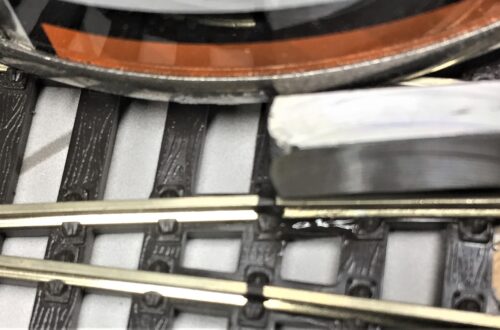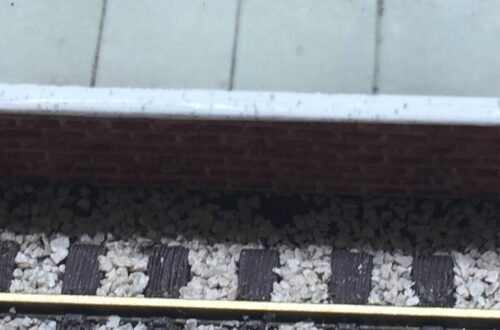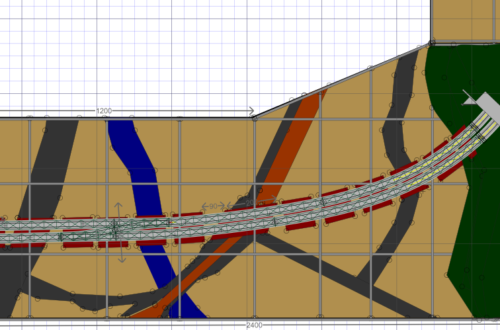-
Oops #2
Baseboard blues On the large baseboard, I built it upside down to make sure the top surface was level (where the train will run). This was a fine idea but I didn’t think through which way the slots should go. I choose from the bottom. The problem with this is that the supports for the section are at either end of the section. This means the forces are effectively trying to stretch the section across the bottom, where the slots are. The upshot of which is the joins between the plywood opened up. Oops. Luckily the whole airframe interlocking meant nothing fell apart but annoying none the less. I’ll have…
-
Old Sag
One of the nice elements of the Saddleworth location is the overlaying of the river Tame with the Huddersfield canal. I just managed to squeeze in the aqueduct that goes over the river and then under the viaduct. It’s not obvious from the picture but what looks to be a bridge is actually an aqueduct. As you might have guessed, the nick name ‘Old Sag’ comes from the slight sag that you can see in the middle. It still seemed to last quite a while. However, even the most well constructed infrastructure will eventually need some kind of repair and this happened in April 2000 and provided a unique view…
-
Skew
I decided to model Saddleworth Viaduct despite it being quite difficult. First off it’s curved which is always a challenge. Then it’s got points on it. That’ll need a seperate post. Then it is long (about 2m scale even with compression, ie removing almost 1/2 the arches) Apart from all that, there are 3 skew arches. With compression I got rid of one but the other two were key. One is over a main road and the other is over the Huddersfield canal. The last one is especially difficult given the multilevel canal that has a loch that drops UNDER the arch.
-
Meccano Memories
So back in the day, Meccano was the LEGO equivalent. I had a handed down set which I used as a kid quite a bit. There was an accompanying magazine as well , which, in the February 1955 edition, featured the Saddleworth station and viaduct. This illustration was based on the most requested photograph of the local photographer Rev. Treacy’s portfolio. Or maybe K Field, depending on where you look. The magazine itself was interesting too. I bought all 12 months of 1955, just for the February edition.
-
The Goods Shed is Hiding
Part of the challenge with Saddleworth Station is that the goods shed wasn’t very active, and it was shut down before the Beeching acts shut the station down. Basically there is scant information on it. The best photos I have don’t give full details. This one showing the most of the shed on the left with the two square openings on the end and what looks to be a chimney. The plans I’ve found are similarly lacking in detail without a view of what’s in the shed. Apart from the track. I’m not even sure if the staging deck connects to the shed via a door. From what I’m guessing,…
-
Saddleworth or what?
During my research I found it a little tricky to get what I needed from google. It turns out that the viaduct is known as Saddleworth Viaduct. Or Uppermill Viaduct. Or even Dobcross Viaduct. So I needed to search through all those terms to get a full view of what was out there on the interwebs. Trying to get a view via google maps or NLS or and geomapping site meant searching out Dobcross UK, not Saddleworth. That’s how I started my planning. I also needed to exclude Australia where there is a Saddleworth station. But there are some nice photos out there on the internet. I like the fretwork…
-
Big Boy Baseboard
The Framework Split In order to avoid lots of joins in the scenic section framework, I decided to split that part into 2 large sections. Each about 2400mm long and about 1100mm deep. This is not really recommended if you’re going to move things around a lot on exhibitions. Especially if you don’t have the appropriate trailer. I’m not thinking about exhibitions (at least not yet). The other reason do two sections that big is that it resulted in a split nicely between the station and the viaduct. Big Boy Of the two, the biggest section contains the station and goods yard as it’s mostly sitting above the valley that…
-
Joining the baseboards
Once I’d built the 4 simple sections (all 80mm deep), I was ready to test my connections idea. I wanted to make the sections relatively easy to pull apart and join back together so I went with alignment dowels and offset latches. Both of these aren’t simple Bunnings or Mitre10 buys (B&Q or Home Dept) so I needed to turn elsewhere. Brass dowels as used by British modelers and screwed in are not cheap and postage makes it worse. In the end I went with eBay push-in aluminium dowels secures with liquid nails. Maybe not as robust as the brass option but seems to work OK. The offset latches were…
-
OK, time to build with plywood
Done the research. Made the plans. Will it actually come together? Ok, gotta start somewhere so let’s start with the easy one: the simple back wall plywood baseboard sections. Each section of the layout is designed to be light and detachable. To do this I decided on 9mm marine plywood. I know a lot of people talk about birch being a better material but frankly too expensive here in Australia for my taste. I also thought about make the cross sections out of thinner plywood to make things even lighter but decided against it. That would have made joins more complex and more difficult to nail. It would have also…
-
Curves
One of the biggest challenges when space is constrained, yet you’re wanting a continuous double loop track, is “curvature”. Too much of a curve will cause a few problems including long coaches hitting each other when passing, catching any scenery (in my case the curved viaduct is a big issue) and basically looking like a train set. I started off by using AnyRail which had 610mm, 761mm and 1219mm set as minimum radii. More than 1219mm being what I aimed for. I couldn’t manage that everywhere and covered most of the visual impacts of the tighter curves. Or a cutting or a tunnel or having them off the scenic section.…




